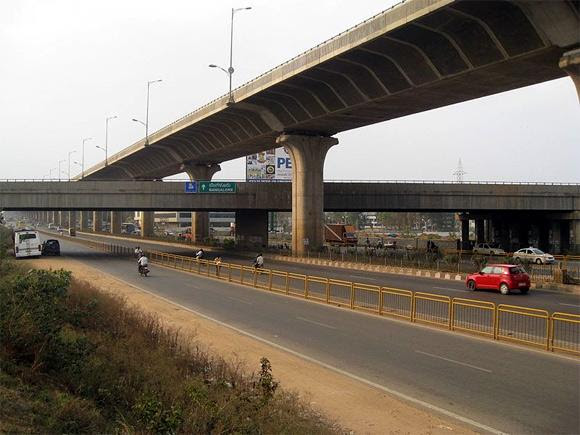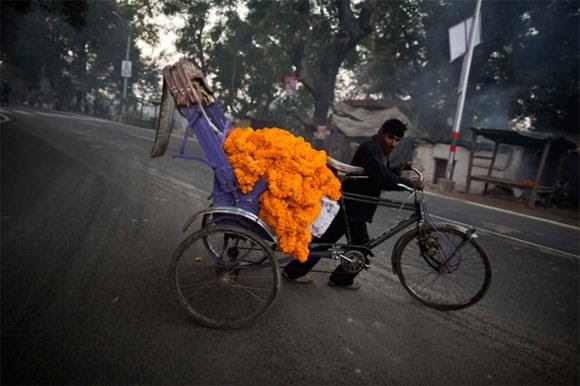India's 10 longest expressways Subject ( ii )Nature teaches us wonderful lessons. The Tale Of The Two Seas
This is in India!!
TAIL PIECE : Interesting Facts
Please go through these photos to see the development
of high ways in India.
Whether it is Golden Quadrilateral Highway project or Diamond
Freight Corridor or Railways,
Kerala is being left behind for reasons best known to all of us!!
India's 10 longest expressways
India has 942 expressways covering a total distance of
1,208.19 kilometres.
These expressways - six or eight-lane highways - with
controlled-access
have made road transportation much faster and
efficient in India.

Yamuna Expressway Uttar Pradesh
Distance: 165 km
India’s longest six-laned Expressway Project was built
to reduce the
travel time between New Delhi and Agra
from 4 hours to 100 minutes.

Built at a cost of Rs 12,839 crore ($2.2 billion), the
Expressway developed
by Jaypee Infratech connects Greater
Noida with Agra in Uttar Pradesh.
The Expressway is also expected to boost the industrial
development of the region.

Outer Ring Road (Hyderabad)
Andhra Pradesh
Distance: 158 km
Built by Hyderabad Metropolitan Development Authority (HMDA),
the Outer Ring Road is an eight-lane ring road expressway
encircling
Hyderabad.
The Rs 6,696 crore (Rs 66.96 billion) mega project was built with
the support of the Japan International Cooperation Agency.
Image: Outer Ring Road (Nehru ORR) at Narsinghi, Hyderabad.

The Expressway offers better
connectivity
between NH 9, NH 7, NH 4 and
some
state highways.
Image: Outer Ring Road (Nehru ORR) at Narsinghi, Hyderabad.

Mumbai Nashik Expressway Maharashtra
Distance: 150 km
One of India’s biggest Expressway projects, it connects
Mumbai
to northern, central and eastern parts of India.
Image: Mumbai Nashik Expressway

Built at a cost of Rs 4,000 crore (Rs 40 billion), it is one
of the largest BOT
(Build-Operate-Transfer) road projects
in India. The road has been
developed by Gammon, Sadbhav
Engineering Limited and B.E. Billimoria & Co.
Image: Mumbai Nashik Expressway.

Kanpur Metropolitan Bypass Uttar Pradesh
Distance: 124 km
Kanpur Metropolitan Bypass connects
Greater Noida to Kanpur.
Image: Kanpur

Kanpur is 378 kms away from the bustling city of Noida.
It is also connected to Delhi by a six-lane highway.
Image: Noida-Delhi Expressway.

Bangalore-Mysore Expressway Karnataka
Distance: 111 km
The Expressway forms a part of the proposed Bangalore-
Mysore Infrastructure Corridor
(BMIC), a 4-6 lane private tolled expressway that connects
Bangalore and Mysore.
Image BMIC Expressway at Mallasandra.

Constructed by Nandi Infrastructure Corridor Enterprises
(NICE),
the first stretch of the Expressway was opened in 2006.
Image: The Junction of the Bangalore-Mysore Infrastructure
Corridor
and Bangalore Elevated Tollway.

Ahmedabad Vadodara Expressway Gujarat
Distance: 95 km
The Ahmedabad Vadodara Expressway has reduced the
travel time between
Ahmedabad and Vadodara from
two and a half hours to one hour.
Image: Ahmedabad Vadodara Expressway

Built at a cost of Rs 475 crore (Rs 4.75 billion), it is
also known as National Expressway.
Image: Ahmedabad Vadodara Expressway

Mumbai-Pune Expressway Maharashtra
Distance: 93 km
The Mumbai-Pune Expressway is India's first six-lane,
concrete, high-speed access-controlled expressway.
Image: Mumbai-Pune Expressway

This picturesque expressway offers a great drive between
Mumbai and Pune, reducing travel time to 2-3 hours.
Image: Mumbai-Pune Expressway

Jaipur-Kishangarh Expressway, Rajasthan
Distance: 90 km
Jaipur-Kishangarh Expressway is a 90 km long access
controlled toll expressway
connecting Jaipur to Kishangarh. Built at a cost of
Rs 729 crore (Rs 7.29 billion), the
expressway was the first Indian road built under the
public-private partnership model.
Image: Jaipur-Kishangarh Expressway .

The expressway forms a segment of the NH-8, which is
a part of the GoldenQuadrilateral
project. Inaugurated in April 2005, the 6-lane expressway
was constructed by GVK
Jaipur Expressway Private Limited (GJEPL) under the
build-operate-transfer model.
Image: A view of Jaipur to Ajmer Road in Rajasthan (India).

Allahabad Bypass Uttar Pradesh
Distance: 86 km
Allahabad Bypass is a access controlled highway, part of Golden
Quadrilateral and National
Highway 2 connecting four
metropolitan cities Delhi, Kolkata, Mumbai and Chennai.
Image: A man transports garlands of marigold flowers
along the banks of
the Ganges river ahead of
Kumbh Mela in Allahabad.

India’s longest bypass section was built by
Larsen & Turbo,
HCC and OSE-KMC (JV). The project
was completed in 2009.

Durgapur Expressway West Bengal
Distance: 65 km
The 65 kilometre-long Dankuni-Palsit stretch is called
Durgapur Expressway.
Image: Durgapur Expressway

Durgapur Expressway links Dankuni with Memari on
Grand Trunk Road.
Image: A structure is on the National Highway-2 in Durgapur.
___________________________________________________________
A tale of Two Seas
A tale of Two Seas Sitting in the Geography class in school,
I remember how fascinated I was when we were being taught
all about the Dead Sea. As you probably recall, the Dead Sea
is really a Lake, not a sea (and as my Geography teacher
pointed out, if you understood that, it would guarantee 4
marks in the term paper!) It’s so high in salt content that the
human body can float easily. You can almost lie down and read
a book! The salt in the Dead Sea is as high as 35% - almost
10 times the normal ocean water. And all that saltiness has
meant that there is no life at all in the Dead Sea. No fish.
No vegetation. No sea animals. Nothing lives in the Dead Sea.
And hence the name: Dead Sea.
While the Dead Sea has remained etched in my memory,
I don't seem to recall learning about the Sea of Galilee in
my school Geography lesson. So when I heard about the
Sea of Galilee and the Dead Sea and the tale of the two seas -
I was intrigued.
It turns out that the Sea of Galilee is just north of the Dead Sea.
Both the Sea of Galilee and the Dead Sea receive their water
from river Jordan. And yet, they are very, very different.
Unlike the Dead Sea, the Sea of Galilee is pretty, resplendent
with rich, colorful marine life. There are lots of plants. And
lots of fish too. In fact, the Sea of Galilee is home to over
twenty different types of fishes.
Same region, same source of water, and yet while one sea
is full of life, the other is dead.
How come?
Here’s apparently why.
The River Jordan flows into the Sea of Galilee and then
flows out. The water simply passes through the Sea of Galilee
in and then out - and that keeps the sea healthy and vibrant,
teeming with marine life. But the Dead Sea is so far below the
mean sea level, that it has no outlet. The water flows in from
the river Jordan, but does not flow out. There are no outlet
streams. It is estimated that over 7 million tons of water
evaporate from the Dead Sea every day leaving it salty,
too full of minerals and unfit for any marine life.
The Dead Sea takes water from the River Jordan, and
holds it. It does not give.
Result ? No life at all.
Think about it.
Life is not just about getting. Its also about giving.
We all need to be a bit like the Sea of Galilee. We are
fortunate to get wealth, knowledge, love and respect. But
if we don't learn to give, we could all end up like the Dead Sea.
The love and the respect, the wealth and the knowledge could
all evaporate. Like the water in the Dead Sea.
If we get the Dead Sea mentality of merely taking in more water,
more money, more everything the results can be disastrous.
It is a good idea to make sure that in the sea of your own life,
you have outlets. Many outlets. For love and wealth - and
everything else that you get in your life. Make sure you don't
just get, you give too.
Open the taps. And you'll open the floodgates to happiness.
Make that a habit. To share. To give.
Experience life. Experience the magic !
------------------------------
Interesting Facts
___________________________________________________________
|
|













Comments
Post a Comment